Adult Care Nursing: Prioritizing Care Using Clinical Reasoning Cycle
VerifiedAdded on 2023/06/14
|13
|2727
|186
Report
AI Summary
This assignment focuses on adult nursing care, emphasizing the application of Miller's functional consequences theory and Levett-Jones' clinical reasoning cycle to develop a priority-based, person-centered care plan for Amalie Jones, an 89-year-old woman with hypothyroidism, macular degeneration, and rheumatoid arthritis. The assignment identifies key nursing priorities such as fall risk management, pain management, and social isolation, detailing specific interventions and goals using the SMART framework. The care plan includes pharmacological and non-pharmacological pain management, community support, and medication self-management strategies, with a three-month evaluation period to assess improvements in the patient's autonomy and overall health. The clinical reasoning cycle is used to design an effective care plan with the aim of fostering dignity and well-being in the patient.
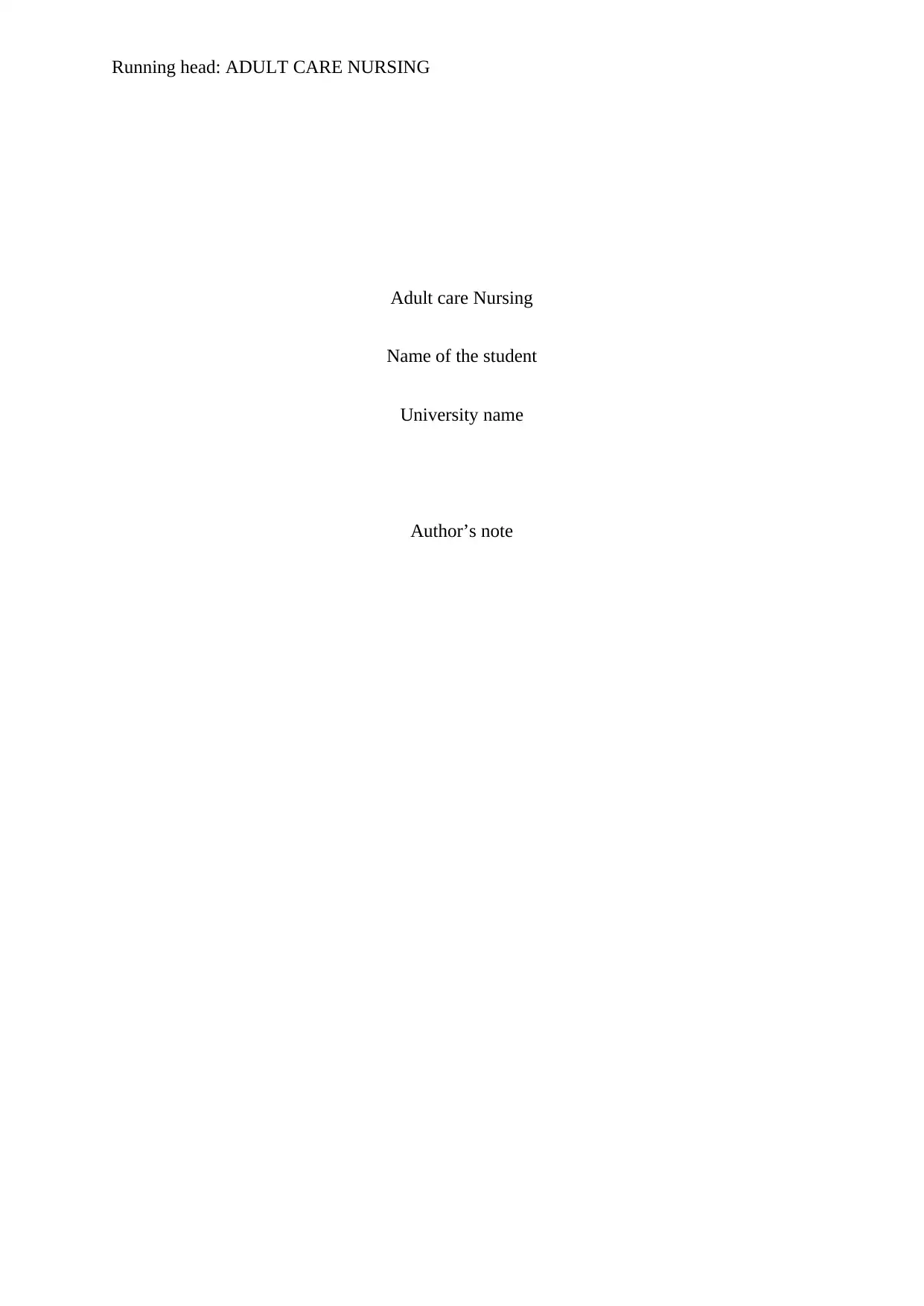
Running head: ADULT CARE NURSING
Adult care Nursing
Name of the student
University name
Author’s note
Adult care Nursing
Name of the student
University name
Author’s note
Paraphrase This Document
Need a fresh take? Get an instant paraphrase of this document with our AI Paraphraser
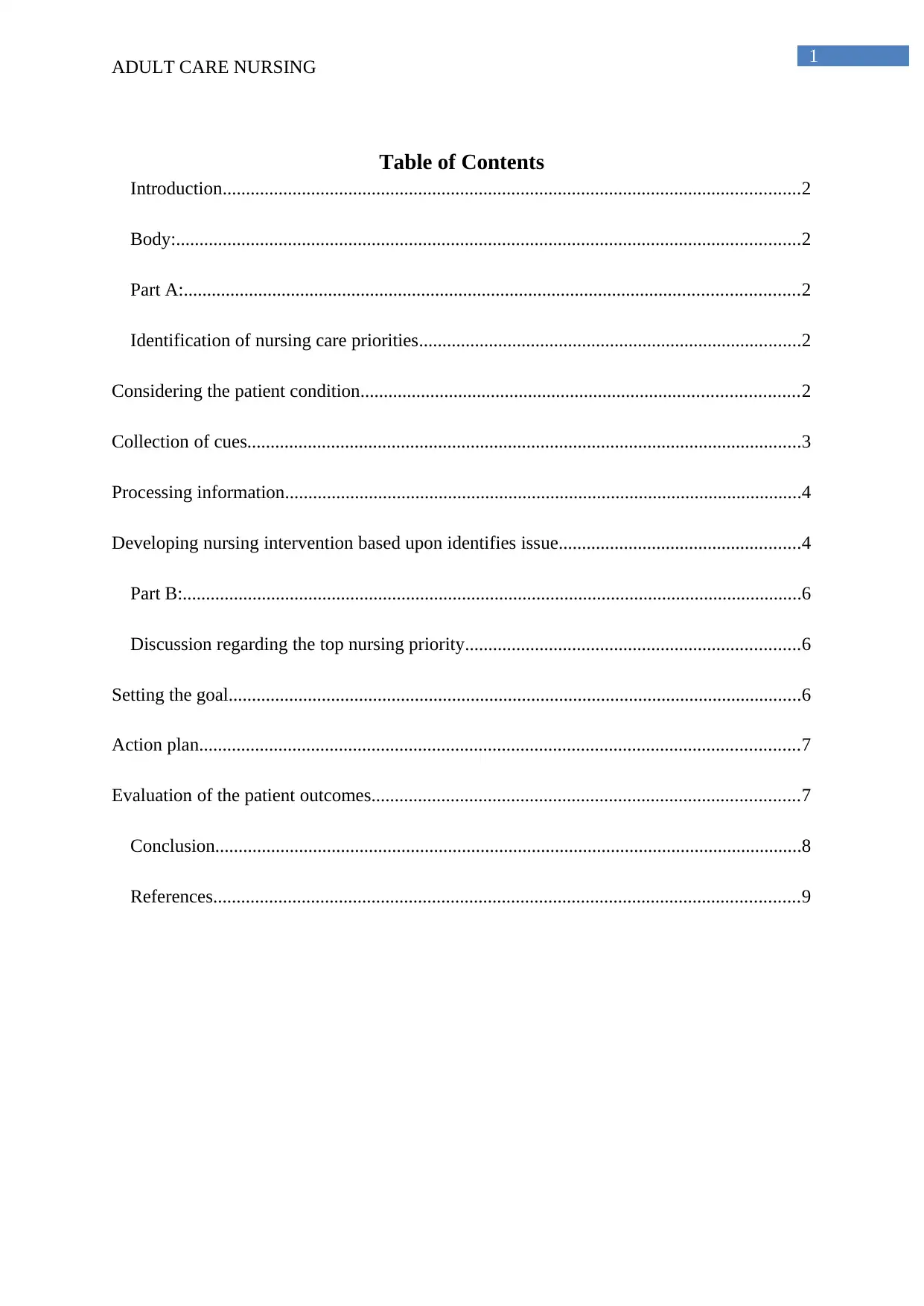
1
ADULT CARE NURSING
Table of Contents
Introduction............................................................................................................................2
Body:......................................................................................................................................2
Part A:....................................................................................................................................2
Identification of nursing care priorities..................................................................................2
Considering the patient condition..............................................................................................2
Collection of cues.......................................................................................................................3
Processing information...............................................................................................................4
Developing nursing intervention based upon identifies issue....................................................4
Part B:.....................................................................................................................................6
Discussion regarding the top nursing priority........................................................................6
Setting the goal...........................................................................................................................6
Action plan.................................................................................................................................7
Evaluation of the patient outcomes............................................................................................7
Conclusion..............................................................................................................................8
References..............................................................................................................................9
ADULT CARE NURSING
Table of Contents
Introduction............................................................................................................................2
Body:......................................................................................................................................2
Part A:....................................................................................................................................2
Identification of nursing care priorities..................................................................................2
Considering the patient condition..............................................................................................2
Collection of cues.......................................................................................................................3
Processing information...............................................................................................................4
Developing nursing intervention based upon identifies issue....................................................4
Part B:.....................................................................................................................................6
Discussion regarding the top nursing priority........................................................................6
Setting the goal...........................................................................................................................6
Action plan.................................................................................................................................7
Evaluation of the patient outcomes............................................................................................7
Conclusion..............................................................................................................................8
References..............................................................................................................................9
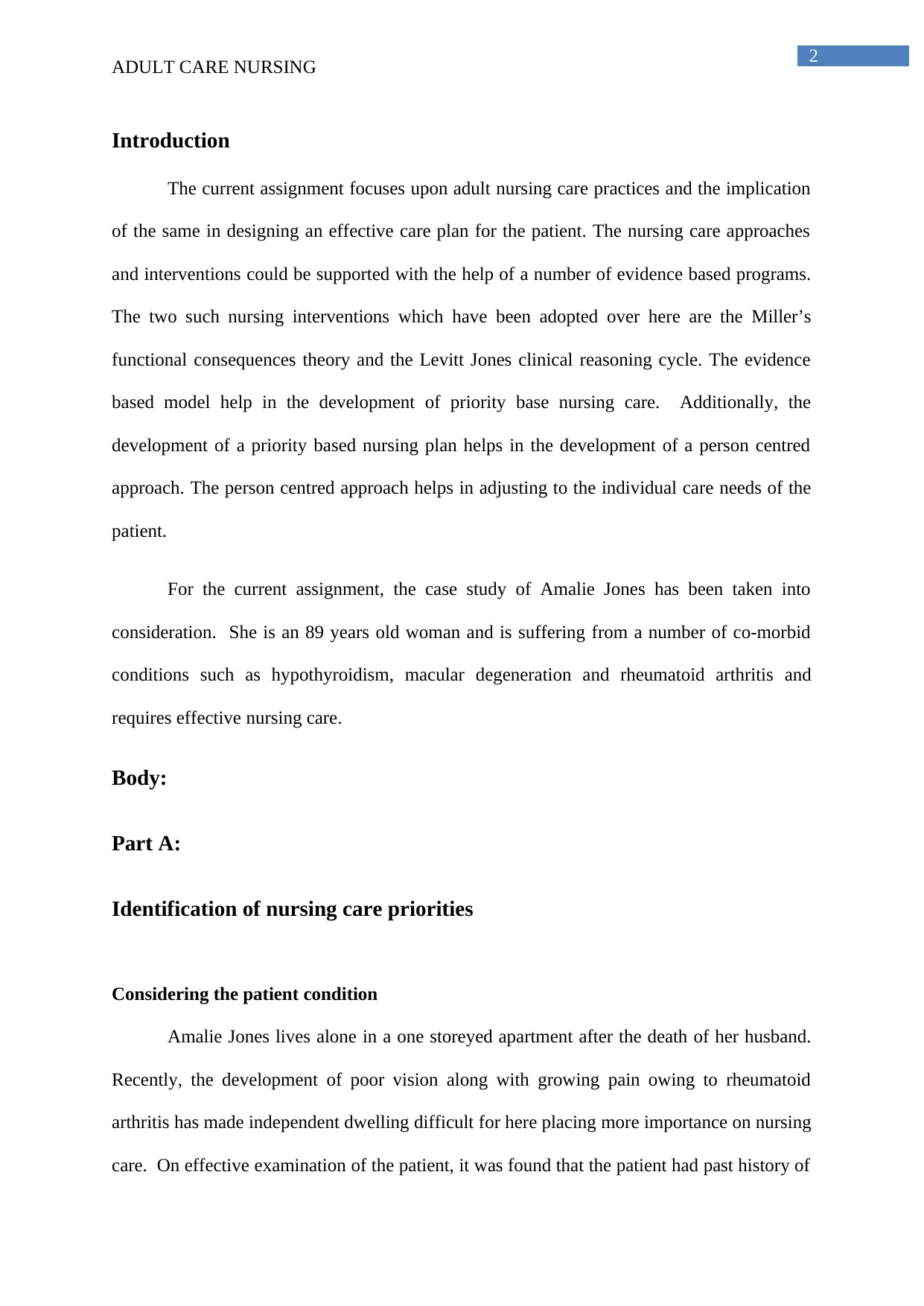
2
ADULT CARE NURSING
Introduction
The current assignment focuses upon adult nursing care practices and the implication
of the same in designing an effective care plan for the patient. The nursing care approaches
and interventions could be supported with the help of a number of evidence based programs.
The two such nursing interventions which have been adopted over here are the Miller’s
functional consequences theory and the Levitt Jones clinical reasoning cycle. The evidence
based model help in the development of priority base nursing care. Additionally, the
development of a priority based nursing plan helps in the development of a person centred
approach. The person centred approach helps in adjusting to the individual care needs of the
patient.
For the current assignment, the case study of Amalie Jones has been taken into
consideration. She is an 89 years old woman and is suffering from a number of co-morbid
conditions such as hypothyroidism, macular degeneration and rheumatoid arthritis and
requires effective nursing care.
Body:
Part A:
Identification of nursing care priorities
Considering the patient condition
Amalie Jones lives alone in a one storeyed apartment after the death of her husband.
Recently, the development of poor vision along with growing pain owing to rheumatoid
arthritis has made independent dwelling difficult for here placing more importance on nursing
care. On effective examination of the patient, it was found that the patient had past history of
ADULT CARE NURSING
Introduction
The current assignment focuses upon adult nursing care practices and the implication
of the same in designing an effective care plan for the patient. The nursing care approaches
and interventions could be supported with the help of a number of evidence based programs.
The two such nursing interventions which have been adopted over here are the Miller’s
functional consequences theory and the Levitt Jones clinical reasoning cycle. The evidence
based model help in the development of priority base nursing care. Additionally, the
development of a priority based nursing plan helps in the development of a person centred
approach. The person centred approach helps in adjusting to the individual care needs of the
patient.
For the current assignment, the case study of Amalie Jones has been taken into
consideration. She is an 89 years old woman and is suffering from a number of co-morbid
conditions such as hypothyroidism, macular degeneration and rheumatoid arthritis and
requires effective nursing care.
Body:
Part A:
Identification of nursing care priorities
Considering the patient condition
Amalie Jones lives alone in a one storeyed apartment after the death of her husband.
Recently, the development of poor vision along with growing pain owing to rheumatoid
arthritis has made independent dwelling difficult for here placing more importance on nursing
care. On effective examination of the patient, it was found that the patient had past history of
⊘ This is a preview!⊘
Do you want full access?
Subscribe today to unlock all pages.

Trusted by 1+ million students worldwide
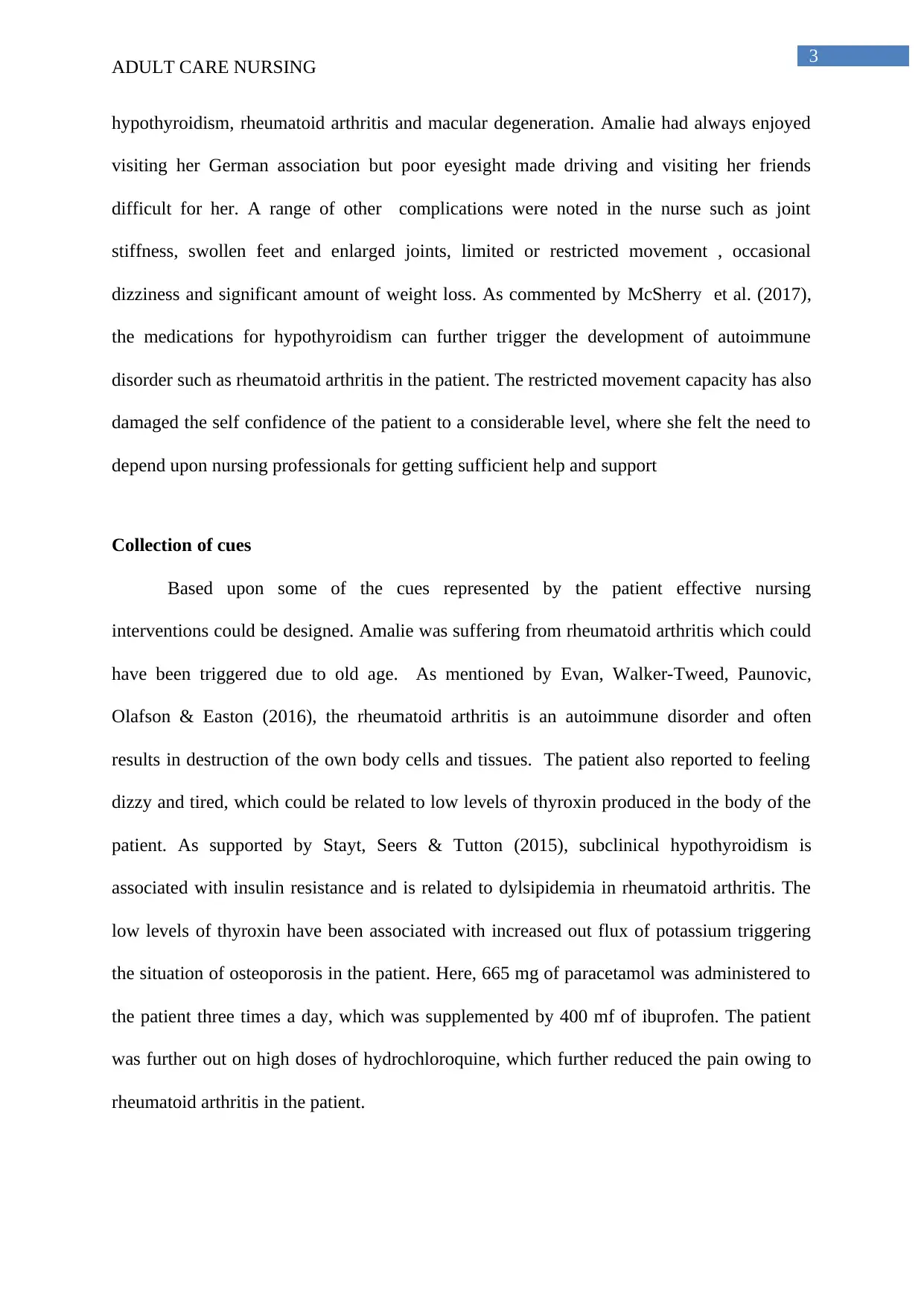
3
ADULT CARE NURSING
hypothyroidism, rheumatoid arthritis and macular degeneration. Amalie had always enjoyed
visiting her German association but poor eyesight made driving and visiting her friends
difficult for her. A range of other complications were noted in the nurse such as joint
stiffness, swollen feet and enlarged joints, limited or restricted movement , occasional
dizziness and significant amount of weight loss. As commented by McSherry et al. (2017),
the medications for hypothyroidism can further trigger the development of autoimmune
disorder such as rheumatoid arthritis in the patient. The restricted movement capacity has also
damaged the self confidence of the patient to a considerable level, where she felt the need to
depend upon nursing professionals for getting sufficient help and support
Collection of cues
Based upon some of the cues represented by the patient effective nursing
interventions could be designed. Amalie was suffering from rheumatoid arthritis which could
have been triggered due to old age. As mentioned by Evan, Walker-Tweed, Paunovic,
Olafson & Easton (2016), the rheumatoid arthritis is an autoimmune disorder and often
results in destruction of the own body cells and tissues. The patient also reported to feeling
dizzy and tired, which could be related to low levels of thyroxin produced in the body of the
patient. As supported by Stayt, Seers & Tutton (2015), subclinical hypothyroidism is
associated with insulin resistance and is related to dylsipidemia in rheumatoid arthritis. The
low levels of thyroxin have been associated with increased out flux of potassium triggering
the situation of osteoporosis in the patient. Here, 665 mg of paracetamol was administered to
the patient three times a day, which was supplemented by 400 mf of ibuprofen. The patient
was further out on high doses of hydrochloroquine, which further reduced the pain owing to
rheumatoid arthritis in the patient.
ADULT CARE NURSING
hypothyroidism, rheumatoid arthritis and macular degeneration. Amalie had always enjoyed
visiting her German association but poor eyesight made driving and visiting her friends
difficult for her. A range of other complications were noted in the nurse such as joint
stiffness, swollen feet and enlarged joints, limited or restricted movement , occasional
dizziness and significant amount of weight loss. As commented by McSherry et al. (2017),
the medications for hypothyroidism can further trigger the development of autoimmune
disorder such as rheumatoid arthritis in the patient. The restricted movement capacity has also
damaged the self confidence of the patient to a considerable level, where she felt the need to
depend upon nursing professionals for getting sufficient help and support
Collection of cues
Based upon some of the cues represented by the patient effective nursing
interventions could be designed. Amalie was suffering from rheumatoid arthritis which could
have been triggered due to old age. As mentioned by Evan, Walker-Tweed, Paunovic,
Olafson & Easton (2016), the rheumatoid arthritis is an autoimmune disorder and often
results in destruction of the own body cells and tissues. The patient also reported to feeling
dizzy and tired, which could be related to low levels of thyroxin produced in the body of the
patient. As supported by Stayt, Seers & Tutton (2015), subclinical hypothyroidism is
associated with insulin resistance and is related to dylsipidemia in rheumatoid arthritis. The
low levels of thyroxin have been associated with increased out flux of potassium triggering
the situation of osteoporosis in the patient. Here, 665 mg of paracetamol was administered to
the patient three times a day, which was supplemented by 400 mf of ibuprofen. The patient
was further out on high doses of hydrochloroquine, which further reduced the pain owing to
rheumatoid arthritis in the patient.
Paraphrase This Document
Need a fresh take? Get an instant paraphrase of this document with our AI Paraphraser
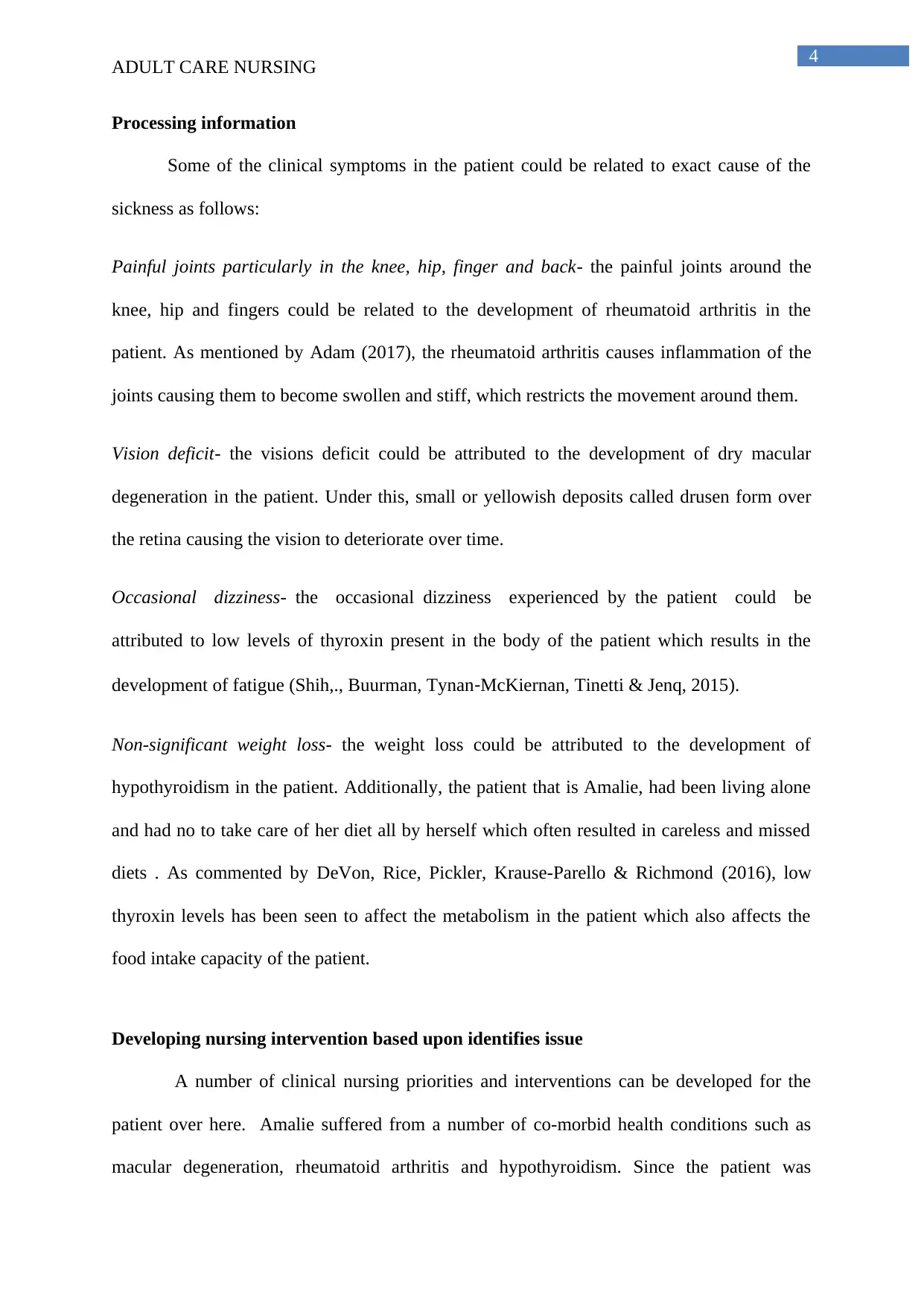
4
ADULT CARE NURSING
Processing information
Some of the clinical symptoms in the patient could be related to exact cause of the
sickness as follows:
Painful joints particularly in the knee, hip, finger and back- the painful joints around the
knee, hip and fingers could be related to the development of rheumatoid arthritis in the
patient. As mentioned by Adam (2017), the rheumatoid arthritis causes inflammation of the
joints causing them to become swollen and stiff, which restricts the movement around them.
Vision deficit- the visions deficit could be attributed to the development of dry macular
degeneration in the patient. Under this, small or yellowish deposits called drusen form over
the retina causing the vision to deteriorate over time.
Occasional dizziness- the occasional dizziness experienced by the patient could be
attributed to low levels of thyroxin present in the body of the patient which results in the
development of fatigue (Shih,., Buurman, Tynan‐McKiernan, Tinetti & Jenq, 2015).
Non-significant weight loss- the weight loss could be attributed to the development of
hypothyroidism in the patient. Additionally, the patient that is Amalie, had been living alone
and had no to take care of her diet all by herself which often resulted in careless and missed
diets . As commented by DeVon, Rice, Pickler, Krause-Parello & Richmond (2016), low
thyroxin levels has been seen to affect the metabolism in the patient which also affects the
food intake capacity of the patient.
Developing nursing intervention based upon identifies issue
A number of clinical nursing priorities and interventions can be developed for the
patient over here. Amalie suffered from a number of co-morbid health conditions such as
macular degeneration, rheumatoid arthritis and hypothyroidism. Since the patient was
ADULT CARE NURSING
Processing information
Some of the clinical symptoms in the patient could be related to exact cause of the
sickness as follows:
Painful joints particularly in the knee, hip, finger and back- the painful joints around the
knee, hip and fingers could be related to the development of rheumatoid arthritis in the
patient. As mentioned by Adam (2017), the rheumatoid arthritis causes inflammation of the
joints causing them to become swollen and stiff, which restricts the movement around them.
Vision deficit- the visions deficit could be attributed to the development of dry macular
degeneration in the patient. Under this, small or yellowish deposits called drusen form over
the retina causing the vision to deteriorate over time.
Occasional dizziness- the occasional dizziness experienced by the patient could be
attributed to low levels of thyroxin present in the body of the patient which results in the
development of fatigue (Shih,., Buurman, Tynan‐McKiernan, Tinetti & Jenq, 2015).
Non-significant weight loss- the weight loss could be attributed to the development of
hypothyroidism in the patient. Additionally, the patient that is Amalie, had been living alone
and had no to take care of her diet all by herself which often resulted in careless and missed
diets . As commented by DeVon, Rice, Pickler, Krause-Parello & Richmond (2016), low
thyroxin levels has been seen to affect the metabolism in the patient which also affects the
food intake capacity of the patient.
Developing nursing intervention based upon identifies issue
A number of clinical nursing priorities and interventions can be developed for the
patient over here. Amalie suffered from a number of co-morbid health conditions such as
macular degeneration, rheumatoid arthritis and hypothyroidism. Since the patient was
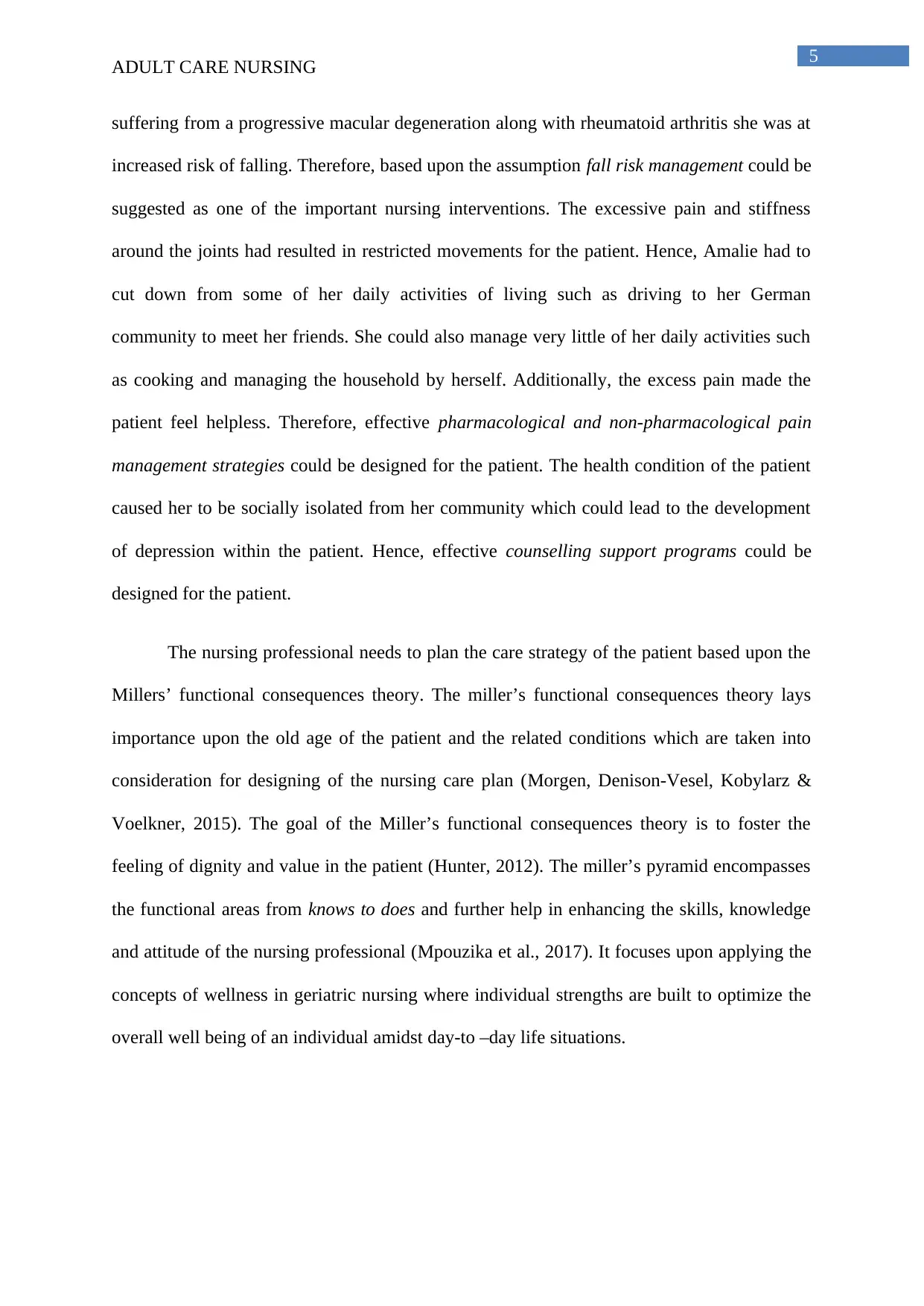
5
ADULT CARE NURSING
suffering from a progressive macular degeneration along with rheumatoid arthritis she was at
increased risk of falling. Therefore, based upon the assumption fall risk management could be
suggested as one of the important nursing interventions. The excessive pain and stiffness
around the joints had resulted in restricted movements for the patient. Hence, Amalie had to
cut down from some of her daily activities of living such as driving to her German
community to meet her friends. She could also manage very little of her daily activities such
as cooking and managing the household by herself. Additionally, the excess pain made the
patient feel helpless. Therefore, effective pharmacological and non-pharmacological pain
management strategies could be designed for the patient. The health condition of the patient
caused her to be socially isolated from her community which could lead to the development
of depression within the patient. Hence, effective counselling support programs could be
designed for the patient.
The nursing professional needs to plan the care strategy of the patient based upon the
Millers’ functional consequences theory. The miller’s functional consequences theory lays
importance upon the old age of the patient and the related conditions which are taken into
consideration for designing of the nursing care plan (Morgen, Denison-Vesel, Kobylarz &
Voelkner, 2015). The goal of the Miller’s functional consequences theory is to foster the
feeling of dignity and value in the patient (Hunter, 2012). The miller’s pyramid encompasses
the functional areas from knows to does and further help in enhancing the skills, knowledge
and attitude of the nursing professional (Mpouzika et al., 2017). It focuses upon applying the
concepts of wellness in geriatric nursing where individual strengths are built to optimize the
overall well being of an individual amidst day-to –day life situations.
ADULT CARE NURSING
suffering from a progressive macular degeneration along with rheumatoid arthritis she was at
increased risk of falling. Therefore, based upon the assumption fall risk management could be
suggested as one of the important nursing interventions. The excessive pain and stiffness
around the joints had resulted in restricted movements for the patient. Hence, Amalie had to
cut down from some of her daily activities of living such as driving to her German
community to meet her friends. She could also manage very little of her daily activities such
as cooking and managing the household by herself. Additionally, the excess pain made the
patient feel helpless. Therefore, effective pharmacological and non-pharmacological pain
management strategies could be designed for the patient. The health condition of the patient
caused her to be socially isolated from her community which could lead to the development
of depression within the patient. Hence, effective counselling support programs could be
designed for the patient.
The nursing professional needs to plan the care strategy of the patient based upon the
Millers’ functional consequences theory. The miller’s functional consequences theory lays
importance upon the old age of the patient and the related conditions which are taken into
consideration for designing of the nursing care plan (Morgen, Denison-Vesel, Kobylarz &
Voelkner, 2015). The goal of the Miller’s functional consequences theory is to foster the
feeling of dignity and value in the patient (Hunter, 2012). The miller’s pyramid encompasses
the functional areas from knows to does and further help in enhancing the skills, knowledge
and attitude of the nursing professional (Mpouzika et al., 2017). It focuses upon applying the
concepts of wellness in geriatric nursing where individual strengths are built to optimize the
overall well being of an individual amidst day-to –day life situations.
⊘ This is a preview!⊘
Do you want full access?
Subscribe today to unlock all pages.

Trusted by 1+ million students worldwide
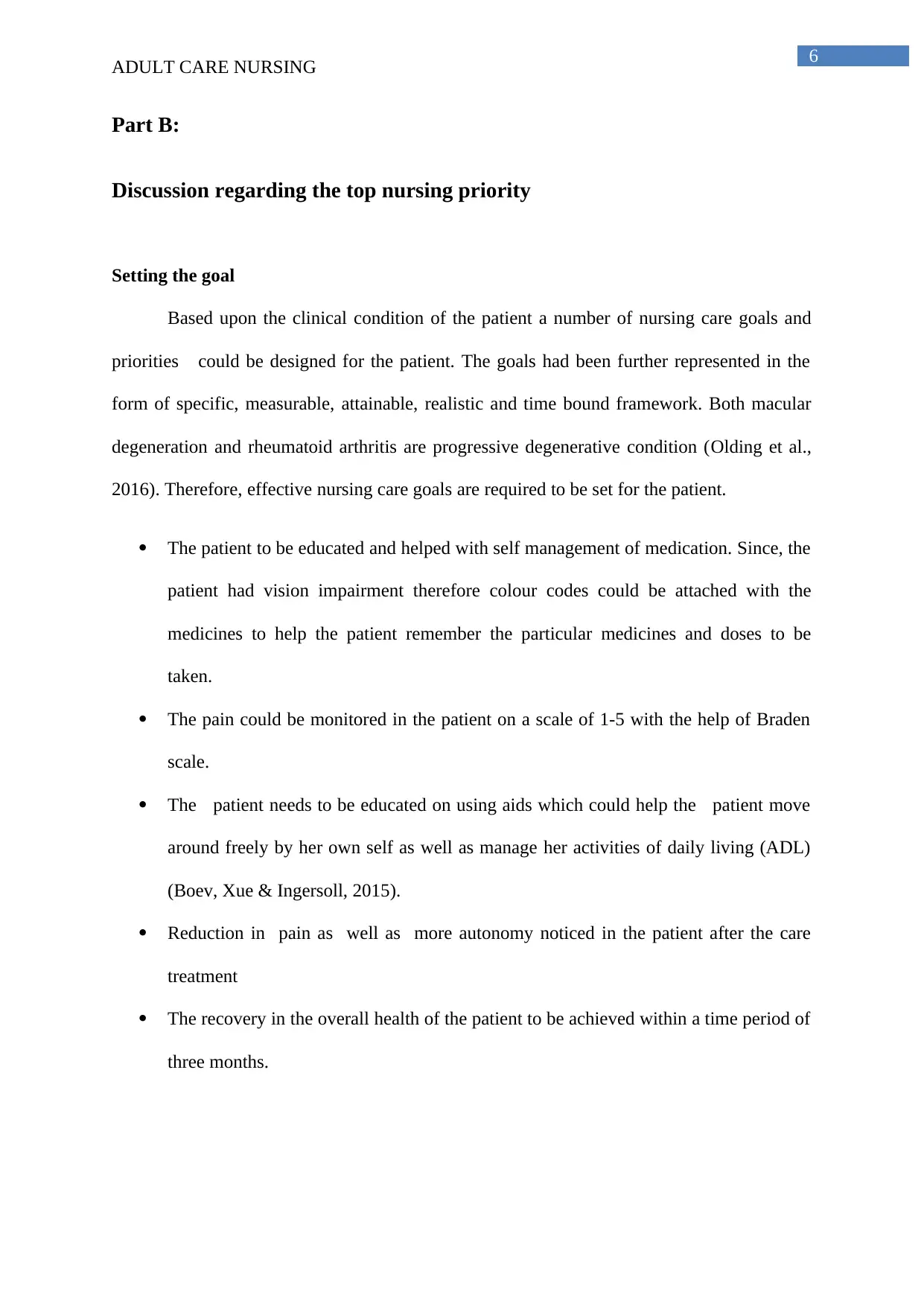
6
ADULT CARE NURSING
Part B:
Discussion regarding the top nursing priority
Setting the goal
Based upon the clinical condition of the patient a number of nursing care goals and
priorities could be designed for the patient. The goals had been further represented in the
form of specific, measurable, attainable, realistic and time bound framework. Both macular
degeneration and rheumatoid arthritis are progressive degenerative condition (Olding et al.,
2016). Therefore, effective nursing care goals are required to be set for the patient.
The patient to be educated and helped with self management of medication. Since, the
patient had vision impairment therefore colour codes could be attached with the
medicines to help the patient remember the particular medicines and doses to be
taken.
The pain could be monitored in the patient on a scale of 1-5 with the help of Braden
scale.
The patient needs to be educated on using aids which could help the patient move
around freely by her own self as well as manage her activities of daily living (ADL)
(Boev, Xue & Ingersoll, 2015).
Reduction in pain as well as more autonomy noticed in the patient after the care
treatment
The recovery in the overall health of the patient to be achieved within a time period of
three months.
ADULT CARE NURSING
Part B:
Discussion regarding the top nursing priority
Setting the goal
Based upon the clinical condition of the patient a number of nursing care goals and
priorities could be designed for the patient. The goals had been further represented in the
form of specific, measurable, attainable, realistic and time bound framework. Both macular
degeneration and rheumatoid arthritis are progressive degenerative condition (Olding et al.,
2016). Therefore, effective nursing care goals are required to be set for the patient.
The patient to be educated and helped with self management of medication. Since, the
patient had vision impairment therefore colour codes could be attached with the
medicines to help the patient remember the particular medicines and doses to be
taken.
The pain could be monitored in the patient on a scale of 1-5 with the help of Braden
scale.
The patient needs to be educated on using aids which could help the patient move
around freely by her own self as well as manage her activities of daily living (ADL)
(Boev, Xue & Ingersoll, 2015).
Reduction in pain as well as more autonomy noticed in the patient after the care
treatment
The recovery in the overall health of the patient to be achieved within a time period of
three months.
Paraphrase This Document
Need a fresh take? Get an instant paraphrase of this document with our AI Paraphraser
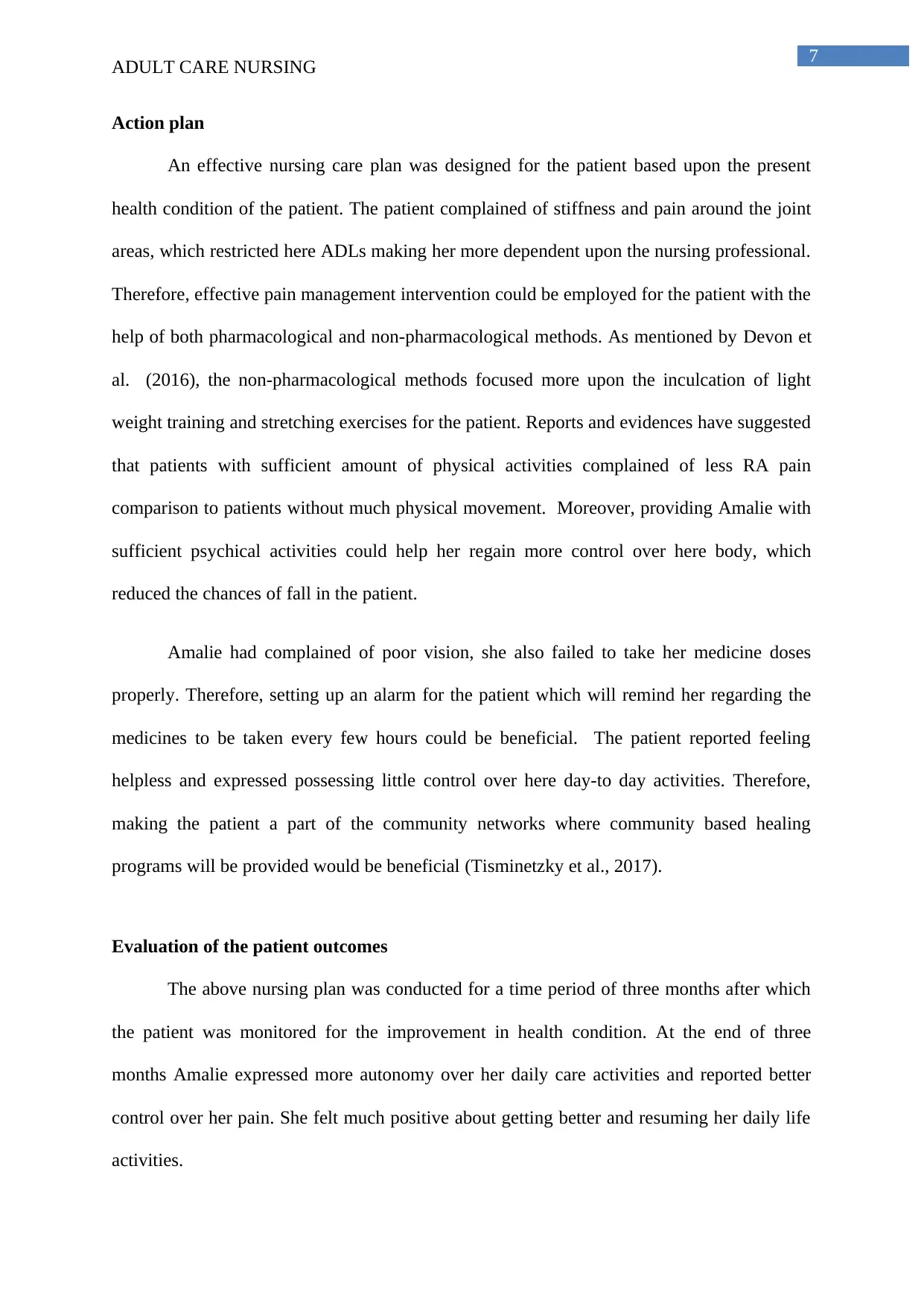
7
ADULT CARE NURSING
Action plan
An effective nursing care plan was designed for the patient based upon the present
health condition of the patient. The patient complained of stiffness and pain around the joint
areas, which restricted here ADLs making her more dependent upon the nursing professional.
Therefore, effective pain management intervention could be employed for the patient with the
help of both pharmacological and non-pharmacological methods. As mentioned by Devon et
al. (2016), the non-pharmacological methods focused more upon the inculcation of light
weight training and stretching exercises for the patient. Reports and evidences have suggested
that patients with sufficient amount of physical activities complained of less RA pain
comparison to patients without much physical movement. Moreover, providing Amalie with
sufficient psychical activities could help her regain more control over here body, which
reduced the chances of fall in the patient.
Amalie had complained of poor vision, she also failed to take her medicine doses
properly. Therefore, setting up an alarm for the patient which will remind her regarding the
medicines to be taken every few hours could be beneficial. The patient reported feeling
helpless and expressed possessing little control over here day-to day activities. Therefore,
making the patient a part of the community networks where community based healing
programs will be provided would be beneficial (Tisminetzky et al., 2017).
Evaluation of the patient outcomes
The above nursing plan was conducted for a time period of three months after which
the patient was monitored for the improvement in health condition. At the end of three
months Amalie expressed more autonomy over her daily care activities and reported better
control over her pain. She felt much positive about getting better and resuming her daily life
activities.
ADULT CARE NURSING
Action plan
An effective nursing care plan was designed for the patient based upon the present
health condition of the patient. The patient complained of stiffness and pain around the joint
areas, which restricted here ADLs making her more dependent upon the nursing professional.
Therefore, effective pain management intervention could be employed for the patient with the
help of both pharmacological and non-pharmacological methods. As mentioned by Devon et
al. (2016), the non-pharmacological methods focused more upon the inculcation of light
weight training and stretching exercises for the patient. Reports and evidences have suggested
that patients with sufficient amount of physical activities complained of less RA pain
comparison to patients without much physical movement. Moreover, providing Amalie with
sufficient psychical activities could help her regain more control over here body, which
reduced the chances of fall in the patient.
Amalie had complained of poor vision, she also failed to take her medicine doses
properly. Therefore, setting up an alarm for the patient which will remind her regarding the
medicines to be taken every few hours could be beneficial. The patient reported feeling
helpless and expressed possessing little control over here day-to day activities. Therefore,
making the patient a part of the community networks where community based healing
programs will be provided would be beneficial (Tisminetzky et al., 2017).
Evaluation of the patient outcomes
The above nursing plan was conducted for a time period of three months after which
the patient was monitored for the improvement in health condition. At the end of three
months Amalie expressed more autonomy over her daily care activities and reported better
control over her pain. She felt much positive about getting better and resuming her daily life
activities.
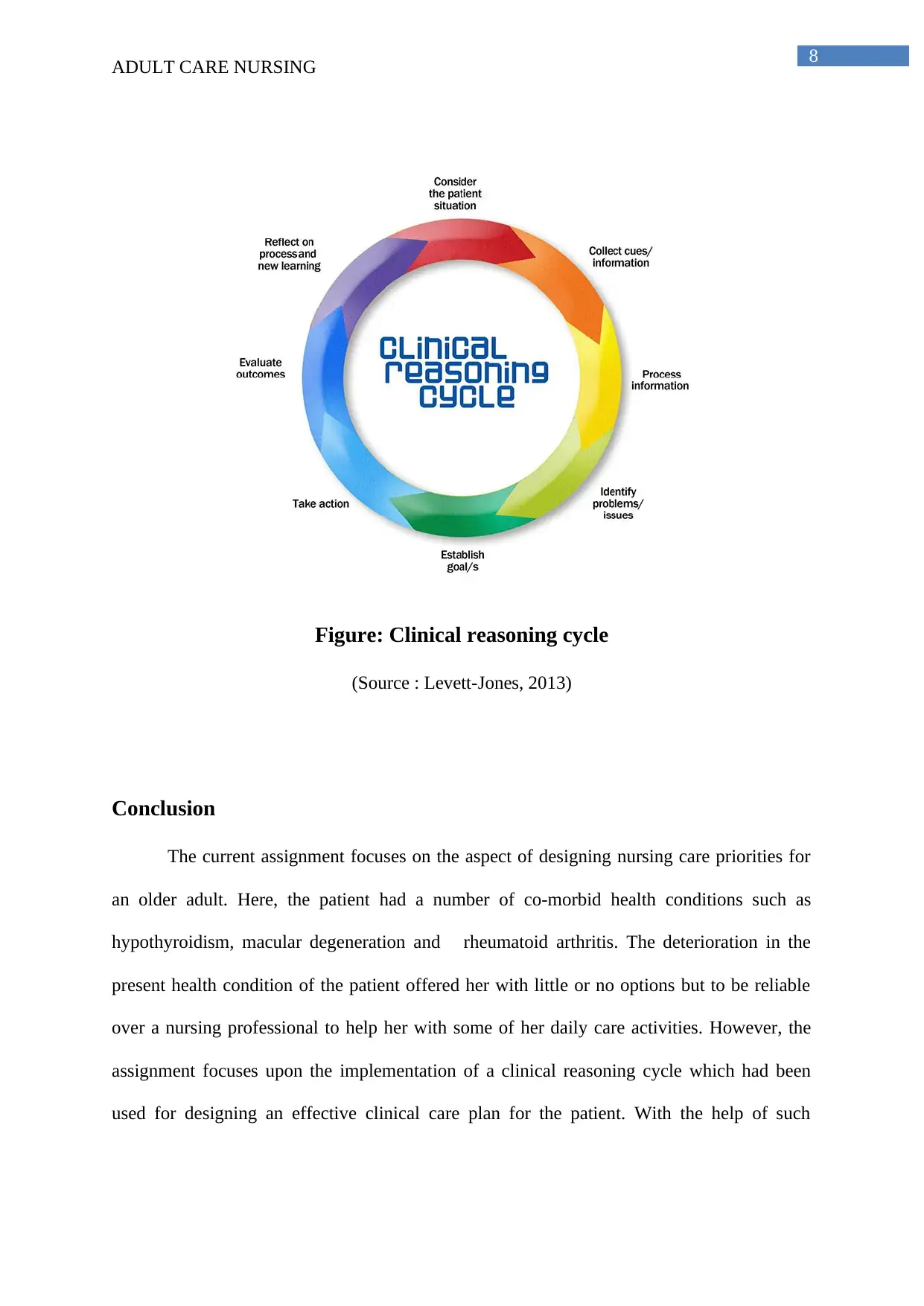
8
ADULT CARE NURSING
Figure: Clinical reasoning cycle
(Source : Levett-Jones, 2013)
Conclusion
The current assignment focuses on the aspect of designing nursing care priorities for
an older adult. Here, the patient had a number of co-morbid health conditions such as
hypothyroidism, macular degeneration and rheumatoid arthritis. The deterioration in the
present health condition of the patient offered her with little or no options but to be reliable
over a nursing professional to help her with some of her daily care activities. However, the
assignment focuses upon the implementation of a clinical reasoning cycle which had been
used for designing an effective clinical care plan for the patient. With the help of such
ADULT CARE NURSING
Figure: Clinical reasoning cycle
(Source : Levett-Jones, 2013)
Conclusion
The current assignment focuses on the aspect of designing nursing care priorities for
an older adult. Here, the patient had a number of co-morbid health conditions such as
hypothyroidism, macular degeneration and rheumatoid arthritis. The deterioration in the
present health condition of the patient offered her with little or no options but to be reliable
over a nursing professional to help her with some of her daily care activities. However, the
assignment focuses upon the implementation of a clinical reasoning cycle which had been
used for designing an effective clinical care plan for the patient. With the help of such
⊘ This is a preview!⊘
Do you want full access?
Subscribe today to unlock all pages.

Trusted by 1+ million students worldwide

9
ADULT CARE NURSING
evidence based approaches, a person centred approach is established for the care of the
patient.
ADULT CARE NURSING
evidence based approaches, a person centred approach is established for the care of the
patient.
Paraphrase This Document
Need a fresh take? Get an instant paraphrase of this document with our AI Paraphraser
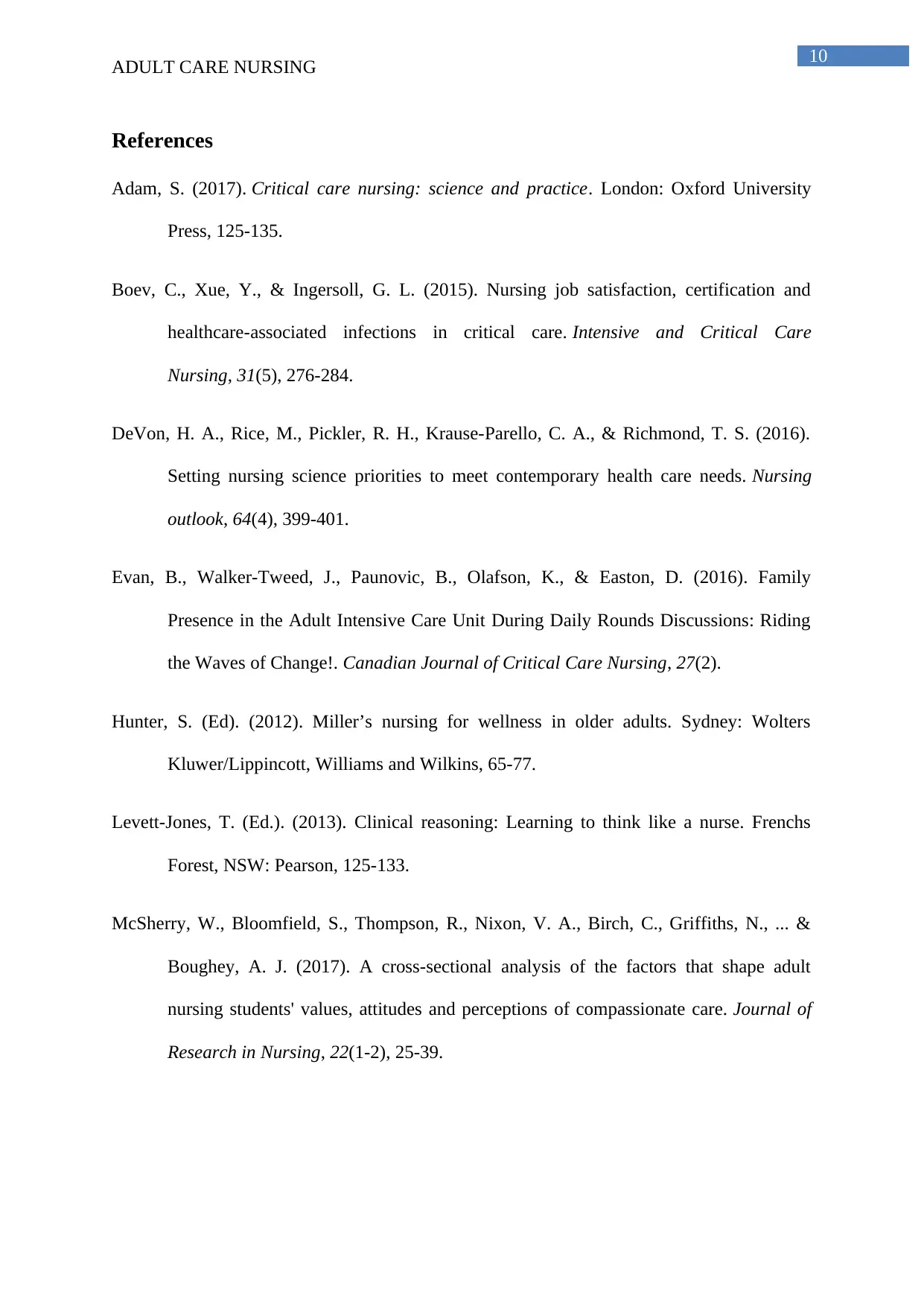
10
ADULT CARE NURSING
References
Adam, S. (2017). Critical care nursing: science and practice. London: Oxford University
Press, 125-135.
Boev, C., Xue, Y., & Ingersoll, G. L. (2015). Nursing job satisfaction, certification and
healthcare-associated infections in critical care. Intensive and Critical Care
Nursing, 31(5), 276-284.
DeVon, H. A., Rice, M., Pickler, R. H., Krause-Parello, C. A., & Richmond, T. S. (2016).
Setting nursing science priorities to meet contemporary health care needs. Nursing
outlook, 64(4), 399-401.
Evan, B., Walker-Tweed, J., Paunovic, B., Olafson, K., & Easton, D. (2016). Family
Presence in the Adult Intensive Care Unit During Daily Rounds Discussions: Riding
the Waves of Change!. Canadian Journal of Critical Care Nursing, 27(2).
Hunter, S. (Ed). (2012). Miller’s nursing for wellness in older adults. Sydney: Wolters
Kluwer/Lippincott, Williams and Wilkins, 65-77.
Levett-Jones, T. (Ed.). (2013). Clinical reasoning: Learning to think like a nurse. Frenchs
Forest, NSW: Pearson, 125-133.
McSherry, W., Bloomfield, S., Thompson, R., Nixon, V. A., Birch, C., Griffiths, N., ... &
Boughey, A. J. (2017). A cross-sectional analysis of the factors that shape adult
nursing students' values, attitudes and perceptions of compassionate care. Journal of
Research in Nursing, 22(1-2), 25-39.
ADULT CARE NURSING
References
Adam, S. (2017). Critical care nursing: science and practice. London: Oxford University
Press, 125-135.
Boev, C., Xue, Y., & Ingersoll, G. L. (2015). Nursing job satisfaction, certification and
healthcare-associated infections in critical care. Intensive and Critical Care
Nursing, 31(5), 276-284.
DeVon, H. A., Rice, M., Pickler, R. H., Krause-Parello, C. A., & Richmond, T. S. (2016).
Setting nursing science priorities to meet contemporary health care needs. Nursing
outlook, 64(4), 399-401.
Evan, B., Walker-Tweed, J., Paunovic, B., Olafson, K., & Easton, D. (2016). Family
Presence in the Adult Intensive Care Unit During Daily Rounds Discussions: Riding
the Waves of Change!. Canadian Journal of Critical Care Nursing, 27(2).
Hunter, S. (Ed). (2012). Miller’s nursing for wellness in older adults. Sydney: Wolters
Kluwer/Lippincott, Williams and Wilkins, 65-77.
Levett-Jones, T. (Ed.). (2013). Clinical reasoning: Learning to think like a nurse. Frenchs
Forest, NSW: Pearson, 125-133.
McSherry, W., Bloomfield, S., Thompson, R., Nixon, V. A., Birch, C., Griffiths, N., ... &
Boughey, A. J. (2017). A cross-sectional analysis of the factors that shape adult
nursing students' values, attitudes and perceptions of compassionate care. Journal of
Research in Nursing, 22(1-2), 25-39.
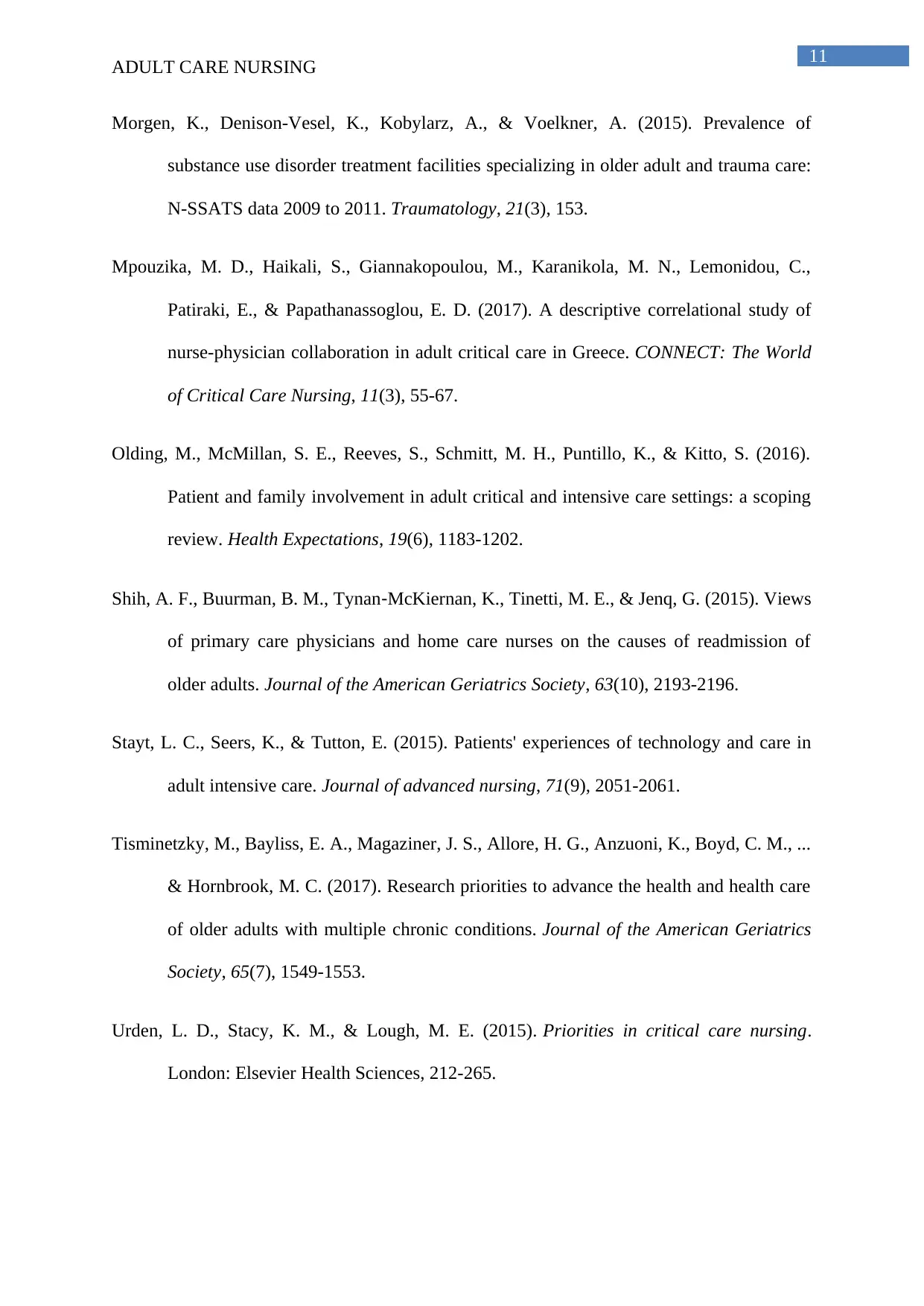
11
ADULT CARE NURSING
Morgen, K., Denison-Vesel, K., Kobylarz, A., & Voelkner, A. (2015). Prevalence of
substance use disorder treatment facilities specializing in older adult and trauma care:
N-SSATS data 2009 to 2011. Traumatology, 21(3), 153.
Mpouzika, M. D., Haikali, S., Giannakopoulou, M., Karanikola, M. N., Lemonidou, C.,
Patiraki, E., & Papathanassoglou, E. D. (2017). A descriptive correlational study of
nurse-physician collaboration in adult critical care in Greece. CONNECT: The World
of Critical Care Nursing, 11(3), 55-67.
Olding, M., McMillan, S. E., Reeves, S., Schmitt, M. H., Puntillo, K., & Kitto, S. (2016).
Patient and family involvement in adult critical and intensive care settings: a scoping
review. Health Expectations, 19(6), 1183-1202.
Shih, A. F., Buurman, B. M., Tynan‐McKiernan, K., Tinetti, M. E., & Jenq, G. (2015). Views
of primary care physicians and home care nurses on the causes of readmission of
older adults. Journal of the American Geriatrics Society, 63(10), 2193-2196.
Stayt, L. C., Seers, K., & Tutton, E. (2015). Patients' experiences of technology and care in
adult intensive care. Journal of advanced nursing, 71(9), 2051-2061.
Tisminetzky, M., Bayliss, E. A., Magaziner, J. S., Allore, H. G., Anzuoni, K., Boyd, C. M., ...
& Hornbrook, M. C. (2017). Research priorities to advance the health and health care
of older adults with multiple chronic conditions. Journal of the American Geriatrics
Society, 65(7), 1549-1553.
Urden, L. D., Stacy, K. M., & Lough, M. E. (2015). Priorities in critical care nursing.
London: Elsevier Health Sciences, 212-265.
ADULT CARE NURSING
Morgen, K., Denison-Vesel, K., Kobylarz, A., & Voelkner, A. (2015). Prevalence of
substance use disorder treatment facilities specializing in older adult and trauma care:
N-SSATS data 2009 to 2011. Traumatology, 21(3), 153.
Mpouzika, M. D., Haikali, S., Giannakopoulou, M., Karanikola, M. N., Lemonidou, C.,
Patiraki, E., & Papathanassoglou, E. D. (2017). A descriptive correlational study of
nurse-physician collaboration in adult critical care in Greece. CONNECT: The World
of Critical Care Nursing, 11(3), 55-67.
Olding, M., McMillan, S. E., Reeves, S., Schmitt, M. H., Puntillo, K., & Kitto, S. (2016).
Patient and family involvement in adult critical and intensive care settings: a scoping
review. Health Expectations, 19(6), 1183-1202.
Shih, A. F., Buurman, B. M., Tynan‐McKiernan, K., Tinetti, M. E., & Jenq, G. (2015). Views
of primary care physicians and home care nurses on the causes of readmission of
older adults. Journal of the American Geriatrics Society, 63(10), 2193-2196.
Stayt, L. C., Seers, K., & Tutton, E. (2015). Patients' experiences of technology and care in
adult intensive care. Journal of advanced nursing, 71(9), 2051-2061.
Tisminetzky, M., Bayliss, E. A., Magaziner, J. S., Allore, H. G., Anzuoni, K., Boyd, C. M., ...
& Hornbrook, M. C. (2017). Research priorities to advance the health and health care
of older adults with multiple chronic conditions. Journal of the American Geriatrics
Society, 65(7), 1549-1553.
Urden, L. D., Stacy, K. M., & Lough, M. E. (2015). Priorities in critical care nursing.
London: Elsevier Health Sciences, 212-265.
⊘ This is a preview!⊘
Do you want full access?
Subscribe today to unlock all pages.

Trusted by 1+ million students worldwide
1 out of 13
Related Documents
Your All-in-One AI-Powered Toolkit for Academic Success.
+13062052269
info@desklib.com
Available 24*7 on WhatsApp / Email
![[object Object]](/_next/static/media/star-bottom.7253800d.svg)
Unlock your academic potential
Copyright © 2020–2025 A2Z Services. All Rights Reserved. Developed and managed by ZUCOL.



